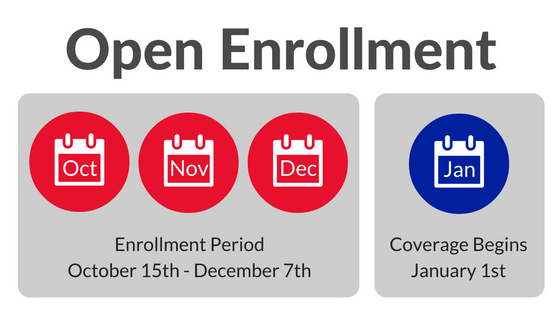What is the Medicare Open Enrollment Period?
The Medicare Open Enrollment Period is the time during which people with Medicare can make new choices and pick plans that work best for them. Each year, Medicare plan costs and coverage typically change. In addition, your health-care needs may have changed over the past year. The Open Enrollment Period is your opportunity to switch Medicare health and prescription drug plans to better suit your needs.
When does the Open Enrollment Period start?
The Medicare Open Enrollment Period begins on October 15 and runs through December 7. Any changes made during Open Enrollment are effective as of January 1, 2019.
During the Open Enrollment Period, you can:
- Join a Medicare Prescription Drug (Part D) Plan
- Switch from one Part D Plan to another Part D Plan
- Drop your Part D coverage altogether
- Switch from Original Medicare to a Medicare Advantage Plan
- Switch from a Medicare Advantage Plan to Original Medicare
- Change from one Medicare Advantage Plan to a different Medicare Advantage Plan
- Change from a Medicare Advantage Plan that offers prescription drug coverage to a Medicare Advantage Plan that doesn’t offer prescription drug coverage
- Switch from a Medicare Advantage Plan that doesn’t offer prescription drug coverage to a Medicare Advantage Plan that does offer prescription drug coverage
What should you do?
Now is a good time to review your current Medicare plan. As part of the evaluation, you may want to consider several factors. For instance, are you satisfied with the coverage and level of care you’re receiving with your current plan? Are your premium costs or out-of-pocket expenses too high? Has your health changed, or do you anticipate needing medical care or treatment?
Open Enrollment Period is the time to determine whether your current plan will cover your treatment and what your potential out-of-pocket costs may be. If your current plan doesn’t meet your health-care needs or fit within your budget, you can switch to a plan that may work better for you.
What’s new in 2019?
Beginning in 2019, Medicare Part D Prescription Drug Plan participants will no longer be exposed to a coverage gap, referred to as the donut hole. Due to changes made by the Bipartisan Budget Act of 2018, Part D participants will see a reduction in their out-of-pocket costs for brand-name drugs from 35% to 25% — a reduction that was originally scheduled to take place in 2020. The gap in coverage for generic drugs will not be closed until 2020. In 2019, Part D participants will pay 37% of the cost of generic drugs.
Also in 2019, the Medicare Advantage Disenrollment Period will be replaced by the Medicare Advantage Open Enrollment Period. The Medicare Advantage Disenrollment Period, which ran from January 1 through February 14, allowed you to drop your Medicare Advantage Plan and return to Original Medicare (Parts A and B) and it allowed you to sign up for a Medicare Part D Prescription Drug Plan. In 2019, a new Medicare Advantage Open Enrollment Period will run annually from January 1 through March 31. If you’re enrolled in a Medicare Advantage Plan, you’ll have the opportunity to switch to another Medicare Advantage Plan, switch to Original Medicare Parts A and B, sign up for stand-alone Medicare Part D Prescription Drug Plan (if you are covered by Original Medicare), or drop your Medicare Part D Prescription Drug Plan.
Part D late enrollment penalty
Generally, if you did not sign up for Part D coverage during your initial enrollment period, and you don’t have other creditable drug coverage (at least comparable to Medicare’s standard prescription drug coverage) for at least 63 days in a row after your initial enrollment period, you may have to pay a late enrollment penalty. The late enrollment penalty is added to your monthly Part D premium. Your initial enrollment period is the seven-month period that starts three months before you turn age 65 (including the month you turn age 65) and ends three months after the month you turn 65.
Where can you get more information?
Determining what coverage you have now and comparing it to other Medicare plans can be confusing and complicated. Pay attention to notices you receive from Medicare and from your plan, and take advantage of help available by calling 1-800-MEDICARE or by visiting the Medicare website, medicare.gov. You can also visit our past blog posts on the topic “5 Questions to Test Your Medicare Knowhow,” and “What’s the latest on Social Security and Medicare Solvency?“

